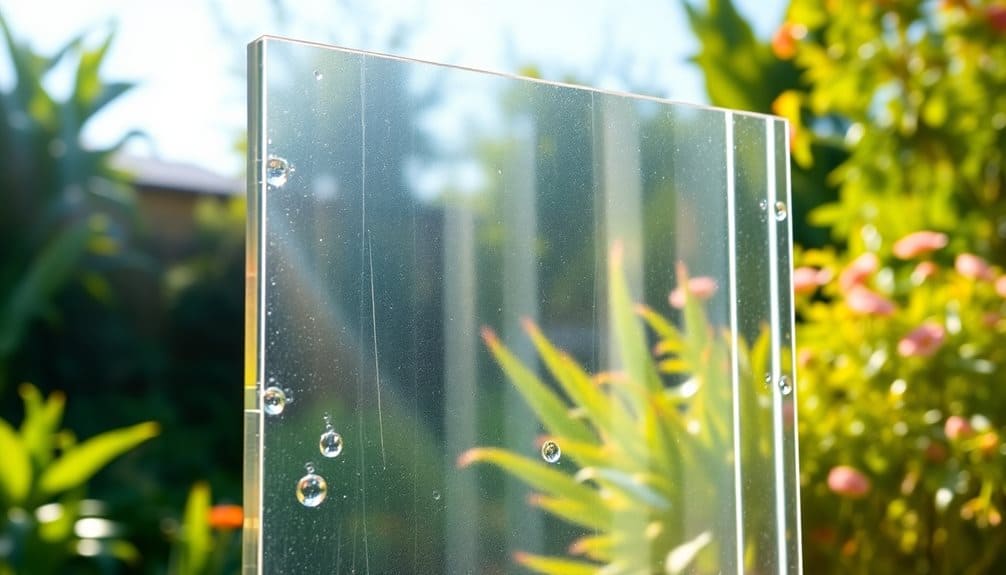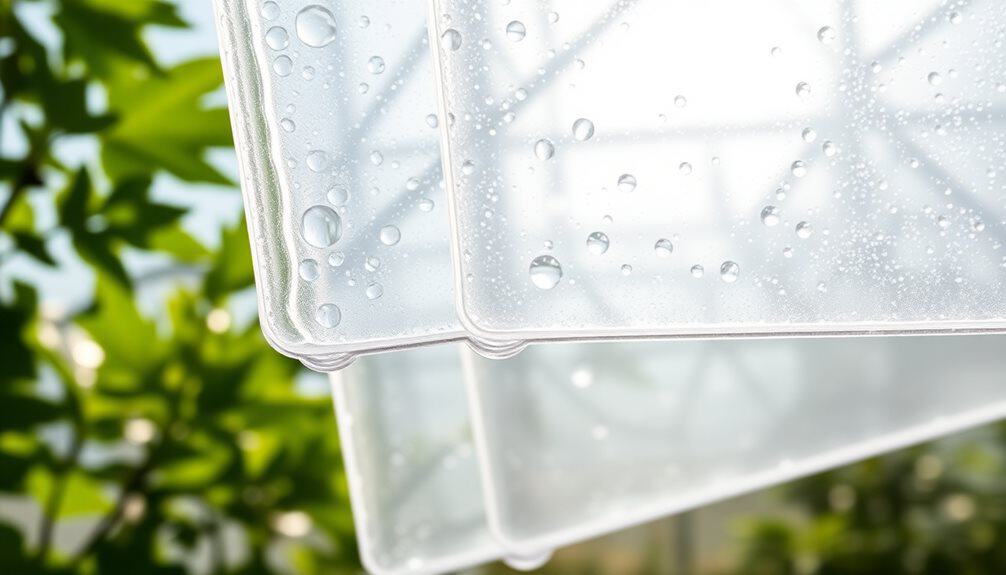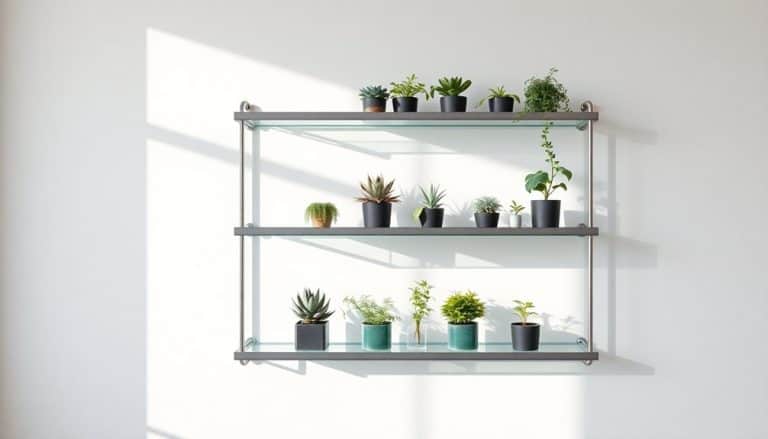This website contains affiliate links. Some products are gifted by the brand to test. As an Amazon Associate, I earn from qualifying purchases. The content on this website was created with the help of AI.
You’ll find three top polycarbonate options for your 2024 greenhouse build: Twin-wall premium panels offer optimal 80-85% light transmission with superior insulation, making them the industry standard. Clear single-layer sheets provide maximum 90% light transmission and flexible installation at a lower cost, ideal for moderate climates. Triple-wall professional grade panels deliver peak thermal efficiency with up to 40% better heat retention, though at a higher initial investment. Your choice should align with your local climate conditions, budget, and growing goals. Understanding each panel’s specific installation requirements and maintenance needs will guarantee your greenhouse’s long-term success.
Key Takeaways
- Triple-wall professional panels offer superior insulation with R-values up to 3.2 and snow load capacity of 32 lbs/sq ft.
- Twin-wall 8mm panels provide optimal balance between durability and light transmission, with 80-85% light penetration and 15-20 year lifespan.
- Clear single-layer sheets deliver maximum light transmission of 90% and offer cost-effective installation for moderate climate zones.
- Triple-wall panels’ tongue-and-groove design prevents condensation and ensures watertight connections, ideal for harsh climates.
- Twin-wall panels feature UV protection on both surfaces, preventing yellowing while maintaining excellent impact resistance against hail.
Twin-Wall Premium Polycarbonate Panels

Twin-wall premium polycarbonate panels stand as the industry standard for greenhouse construction, offering an excellent balance of light transmission and thermal insulation. These panels feature two parallel walls connected by internal ribs, creating air chambers that provide superior R-value compared to single-layer materials. You’ll find they typically transmit 80-85% of available light while diffusing it effectively to prevent hot spots and plant burn.
The structural design of twin-wall panels means you’re getting excellent impact resistance, with most premium options rated to withstand significant hail and snow loads. They’re available in thicknesses ranging from 4mm to 16mm, with 8mm being ideal for most greenhouse applications. You’ll want to take into account that thicker panels offer better insulation but slightly reduced light transmission.
When selecting twin-wall panels, you’ll need to verify UV protection on both surfaces, as this prevents yellowing and extends the material’s lifespan to 15-20 years. The panels’ weight (typically 1.5 kg/m²) makes installation manageable, while their compatibility with standard H-channels and U-profiles ensures straightforward assembly. Installation requires maintaining proper thermal expansion gaps of approximately 3mm per meter.
Clear Single-Layer Greenhouse Sheets

Simplicity defines clear single-layer polycarbonate sheets as the most straightforward option for greenhouse construction. These sheets offer direct light transmission of up to 90%, making them ideal for plants requiring maximum sunlight exposure. You’ll find them particularly useful in regions with limited natural light or during shorter winter days.
The single-layer construction provides basic insulation while maintaining structural integrity. At 0.8mm to 2mm thick, these sheets are lighter than glass yet offer 200 times more impact resistance. You’ll appreciate their flexibility during installation, as they can be cut and bent to accommodate various greenhouse designs.
- UV-protected surface coating extends sheet life by preventing yellowing and degradation
- Direct light transmission maximizes photosynthesis potential for peak plant growth
- Lower initial cost compared to twin-wall or triple-wall alternatives
- Quick installation with standard greenhouse hardware and minimal specialized tools
When selecting single-layer sheets, you’ll need to evaluate the trade-off between light transmission and heat retention. While they excel at light penetration, they don’t provide the same level of thermal insulation as multi-wall options. For moderate climates, however, they’re often the most cost-effective solution for hobby greenhouses and small commercial operations.
Regular maintenance including weekly debris removal helps ensure optimal light transmission and extends the lifespan of your greenhouse panels.
Triple-Wall Professional Grade Panels

Professional growers seeking maximum thermal efficiency and durability will find triple-wall polycarbonate panels an ideal choice for commercial greenhouse applications. These panels feature three distinct layers separated by two air chambers, delivering superior R-values between 2.7 and 3.2, markedly outperforming single-layer options. You’ll achieve up to 40% better heat retention while maintaining 75-80% light transmission.
The structural design of triple-wall panels provides enhanced load-bearing capacity, typically handling snow loads up to 32 lbs/sq ft and wind speeds of 130 mph. You’re getting 16mm thickness that won’t buckle under extreme weather conditions. The panels’ co-extruded UV protection layer prevents yellowing and extends service life to 15-20 years.
For installation, you’ll need H-channels and aluminum profiles rated for 16mm thickness. The panels’ tongue-and-groove design guarantees watertight connections, while the multi-wall structure prevents condensation drip. You can expect operating temperatures to remain stable within ±5°F of your target, making these panels particularly suitable for climate-sensitive crops and year-round growing operations. The initial investment is higher, but you’ll recover costs through reduced heating expenses and improved crop yields.
Frequently Asked Questions
How Long Does UV Protection Typically Last on Polycarbonate Greenhouse Sheets?
You’ll find that UV protection on polycarbonate greenhouse sheets typically lasts 10-15 years, depending on the coating quality and environmental conditions. Premium sheets with co-extruded UV protection layers maintain their effectiveness longer than surface-coated alternatives. You’ll need to monitor for yellowing and brittleness, as these indicate UV protection deterioration. In extreme climates, protection can degrade faster, particularly at high altitudes or in intense sunlight.
Can Polycarbonate Sheets Be Cleaned With Standard Household Cleaning Products?
You’ll need to be selective with cleaning products for polycarbonate sheets, as harsh chemicals can damage the material. Stick to mild soap solutions and warm water, avoiding ammonia-based cleaners, abrasive materials, or strong solvents. You can safely use specialized polycarbonate cleaners or diluted dish soap. After cleaning, rinse thoroughly with clean water to prevent residue buildup that could compromise light transmission and material integrity.
What Is the Maximum Snow Load These Sheets Can Withstand?
You’ll find that polycarbonate sheets’ snow load capacity varies by thickness and structure. Double-wall 8mm sheets typically withstand 15-20 lbs/sq ft, while 16mm triple-wall panels can handle up to 40 lbs/sq ft. For ideal performance, you’ll need to maintain a minimum 10-15 degree roof pitch. To calculate your specific needs, multiply your region’s average snowfall density by expected accumulation depth.
Are Polycarbonate Sheets Safe for Growing Organic Vegetables Underneath?
You can safely grow organic vegetables under polycarbonate sheets as they’re FDA-approved and don’t leach harmful chemicals into your growing environment. These sheets are BPA-free and UV-resistant, preventing degradation that could compromise food safety. They maintain peak light transmission while filtering out harmful UV rays, creating an ideal environment for organic crop production. Your plants will receive 85-90% of available light without chemical exposure risks.
How Do You Prevent Algae Growth Between Multi-Wall Polycarbonate Panels?
Like raindrops trapped in a bottle, moisture between polycarbonate panels creates the perfect environment for algae. You’ll want to seal all panel edges with anti-dust tape specifically designed for polycarbonate, ensuring the top edge has solid aluminum tape and the bottom uses breathable tape. Install panels with a minimum 5° pitch to promote water runoff, and drill small drainage holes at the bottom channels to prevent water accumulation.




